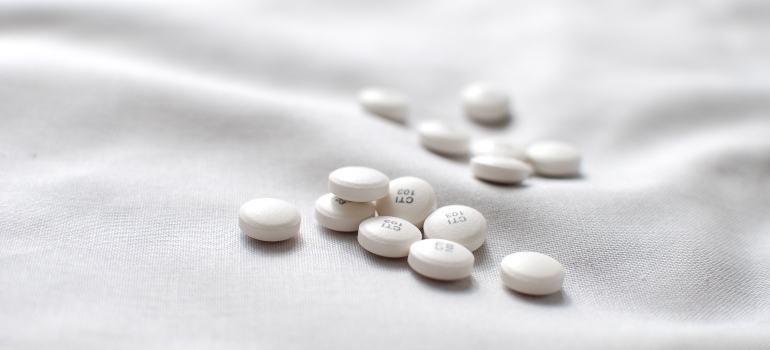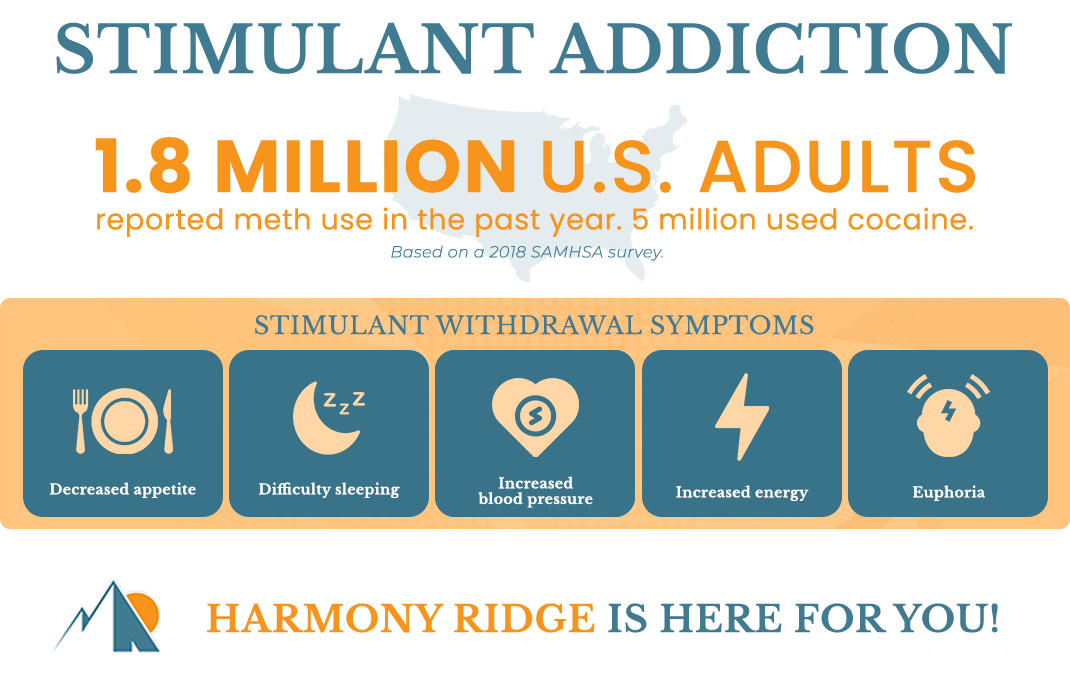Stimulant Addiction
Discover the path to recovery from stimulant addiction and find the help you need at Harmony Ridge.
When it comes to the most commonly abused drugs in the United States, stimulants take the cake. This is perhaps because stimulants can be found in both prescriptions and illicit substances. But what are stimulants, exactly? Don’t they just make people hyperactive and pay attention? Are they addictive, and is stimulants rehab at a West Virginia treatment center necessary? Unfortunately, the answer to the last two questions is yes. But on the other side, addiction is a disease, one that can be treated at Harmony Ridge Recovery Center. Contact us today, and we will help you start, go through, and complete your road to recovery!

What Do Stimulants Do to the Body?
A stimulant is a substance that makes its way to the central nervous system to impact cognitive function. A stimulant’s job is to maximize a person’s cognitive brain function, but how does it happen? When someone takes a stimulant, dopamine and norepinephrine travel to the brain. This is what allows a person’s concentration to increase. Not only that, but this also works to decrease fatigue. Needless to say, pretty much everyone requires an increase in concentration and reduced fatigue from time to time. This is one of the primary reasons why stimulant addiction is so rampant as it is.
Stimulants were primarily designed for medical purposes. Those who suffer from attention-deficit hyperactivity disorder (ADHD) or other attention disorders often become bogged down by excessive fatigue and lack of concentration, after all. Stimulants, in a medical sense, are mostly used for these individuals. While in these cases they can be beneficial, stimulants can also cause negative effects in regards to developing a substance use disorder and substance addiction. It is all too common for people to start taking stimulants in way higher doses than they should, ending up in a stimulants addiction rehab center.
Commonly Abused Prescription Stimulants
As it relates to substance use disorder, stimulants are among the most abused drugs. Some commonly abused stimulants include, but are not limited to, the following:
- Adderall
- Ritalin
- Concerta
- Dexedrine
- Desoxyn
- Ephedrine
All of the stimulants listed above are some sort of amphetamine, methylphenidate, or dextroamphetamine. These kinds of stimulants are among the most commonly used in regard to prescriptions. They are most often used to treat attention disorders such as attention deficit disorder (ADD) and other disorders such as narcolepsy and obesity. However, the fact that these stimulants are “readily available” means that many people choose to abuse them.
Abusing prescription stimulants can lead to various negative consequences and traumatic experiences. Many people that have undergone EMDR therapy for drug addiction state that their stimulant addiction is to blame for the traumas. It all starts with only slightly increasing the prescribed dosage, ending up with a full-blown substance abuse issue.

The Purpose of Prescription Stimulants
Doctors prescribe stimulants because if someone has a poor attention span, the stimulants will provide more focus and energy. Attention disorders have a way of really killing someone’s motivation and plaguing them with fatigue. This makes it difficult for them to do anything that requires even the slightest amount of energy. Not only that, but these disorders also make it easy for people to forget things or misplace common everyday items.
Prescription stimulants are dangerous to use in the case of many. This is because the side effects of stimulants are quite a bit to handle, whether they be amphetamine, methylphenidate, or dextroamphetamine. Furthermore, abusing stimulants for a long period of time will usually result in addiction and attendance at a cognitive behavioral therapy for substance use disorders program as part of stimulants rehab. Luckily, some time at a stimulants addiction rehab center is usually enough to get “back on track”.
Different stimulants have different side effects and different withdrawal symptoms. That is why it is important to understand each stimulant and the way it affects your mind and body. Let’s take a look at some of the most common stimulants of today.
Adderall
The most widely used of all the prescription amphetamines in cases of ADHD, Adderall fulfills the purpose of sending dopamine to the brain. This happens so that someone who feels sluggish and inattentive can pay better attention and have the energy to maintain focus. When it comes to prescription amphetamines, Adderall addiction is by far the most common, as the drug is the most widely prescribed one in the U.S.
The way that Adderall works is by increasing the dopamine delivered to the brain. This could mean increased tolerance over time, which is not ideal as it can lead to dependence. This is why doctors are always careful not to prescribe too high a dosage for their patients. This is done in an effort to prevent someone from developing a dependency on a high dosage of stimulants. It’s always easier to add on to a prescription rather than try cutting back; this is when dependency happens.
Cutting down on Adderall means that the person will need to rely on other means of dopamine production. That is why art therapy rehabilitation is one of the best treatment modalities to help people overcome their Adderall addiction. Creating art releases dopamine, the same as Adderall does, but without any adverse effects.

Ritalin
Ritalin is considered to be the counterpart to Adderall. This substance, in particular, is methylphenidate. The similarities between methylphenidates and amphetamines are thin in that both of them are used to treat attention disorders. Methylphenidates like Ritalin are milder than amphetamines. However, the danger of getting addicted to Ritalin is no less. That said, treating a Ritalin addiction is (generally speaking) much easier than treating an addiction to Adderal. Many people choose to undergo holistic therapy for addiction in this case, as their withdrawal symptoms are not overly difficult to handle.
Concerta
Approved by the government in 2000 and used primarily to treat attention disorders, Concerta is a stimulant that amplifies focus and helps tranquilize impulsivity and hyperactive behavior. Concerta could be considered an alternative form of Ritalin. In other words, everything that applies to Ritalin addiction applies to Concerta as well, meaning that stimulants rehab is necessary.
Dexedrine
Dexedrine is a central nervous system stimulant used primarily to treat ADHD since the late 1970s. This drug is an amphetamine, introduced in the United States military as a drug that would help soldiers with combating fatigue on exhausting missions. This stimulant is also referred to as dextroamphetamine. Most people that develop a Dexedrine addiction require inpatient drug rehab in VW due to strong withdrawal symptoms. But with proper care and support, even a Dexedrine addiction can be overcome with relative ease.
Desoxyn
Desoxyn’s origins trace back to 1947, primarily used to treat obesity. Fast forward to today, and this methamphetamine is used to treat ADHD and other attention disorders. This methamphetamine, however, is slightly less addictive than others and may only require you to enroll in an intensive outpatient program in West Virginia instead of an inpatient one. Of course, it all depends on the length and intensity of Desoxyn abuse.

Ephedrine
Ephedrine is unlike most other prescription stimulants. While it has similar effects, its purpose is different from the others. Ephedrine is used to reduce a person’s appetite, primarily treating low blood pressure and obesity. Those with asthma also benefit from its use because it acts as a bronchodilator. Those who suffer from bronchial asthma typically experience shortness of breath, wheezing, and tightness in the chest, all symptoms that ephedrine can alleviate. Ephedrine is usually sold over the counter; it is also an ingredient used in meth labs. It is quite possible to develop an Ephedrine addiction, as it is a highly addictive stimulant in its own right. Don’t let this over-the-counter prescription fool you into thinking it is harmless. It is anything but.
Illicit Stimulants
Illicit stimulants are what is referred to when speaking of illegal drugs such as cocaine, crystal meth, and crack. When people hear the word “stimulant,” this is usually what comes to mind because there are so many individuals that abuse them. While they’re similar to the overall effect of prescription stimulants, the intensity and how they are produced are vastly different. For example, prescription stimulants are designed to distribute their effects over an extended amount of time, whereas illicit substances come right out the gate with intense effects, lasting only a few minutes. In some cases, such as with cocaine addiction, these stimulants may feel necessary for day-to-day functioning. Furthermore, you never know what’s inside illicit stimulants. They can be (and often are) “laced” with other chemicals to improve their short-term effects. But that comes at a very high cost indeed.
Stimulant Withdrawal
Stimulant withdrawal is one of the primary reasons why people seek stimulants rehab in the first place. For a person with stimulant addiction, it can be rather difficult to imagine their life without the effects of stimulants in the first place. Some effects of stimulants include the following:
- Decreased appetite
- Talkativeness
- Difficulty sleeping
- Increased blood pressure
- Nervousness
- Euphoria
- Increased energy
- Increased focus
But when withdrawal symptoms kick in, that’s where real troubles start. Because of the likelihood of addiction or substance abuse, prescription stimulants are considered schedule II drugs. What’s most ironic about prescription stimulants is that they are not used to get high but rather to enhance one’s performance. Students are perhaps among those who abuse prescription stimulants the most due to the pressure of performing well academically. In the U.S., 900,000 people abuse prescription stimulants every month.
Stimulants are responsible for sending dopamine to the brain, and if someone is abusing the substance, they run the risk of compromising their pleasure center. Once this happens, it will become more difficult to find pleasure in things that normally bring someone the most satisfaction. This is due to the immense amounts of dopamine the brain is receiving from stimulants and the inability to reproduce their effects with normal everyday events.
Quitting stimulants (or any drug for that matter) cold turkey causes an individual to experience intense withdrawal symptoms. Withdrawal is what is most commonly referred to when someone is so used to the chemical effects that a drug has on them that their body reacts harshly to being without it. Those who experience withdrawal need more of a substance over time because of the tolerance that has been built. When this happens, addiction is more than likely around the corner.
Stimulant Addiction Treatment Options
Substance use disorder is a difficult obstacle to face. Not only is it physically exhausting to recover from addiction, but the psychological toll it has on a person is unmatched. It’s imperative to the physical and emotional well-being of a person to seek the help they need. The problem is that it’s difficult to know where to start. But that is where Harmony Ridge Recovery Center comes in. With just a simple phone call or an email, you can have access to numerous treatment modalities, including:
- Inpatient residential treatment
- Intensive outpatient treatment
- Partial hospitalization program
- Medication-assisted treatment (MAT)
At Harmony Ridge, we pride ourselves on customizing our treatment programs to the exact needs of our patients. No one is a number at Harmony; everyone gets the best possible care and attention. We are especially proud of our rehab for veterans programs, as we have some of the best medical specialists in the country working with us!

Each stimulants rehab treatment modality is designed to provide the best level of care and support, depending on the severity of the addiction.
Inpatient Treatment
Inpatient residential treatment is primarily for individuals who experience more severe forms of addiction. This treatment method could last anywhere from 28 days to six months, depending on the severity of the addiction and the way an individual responds to treatment. Those who participate in residential treatment receive 24/7 care from medical professionals at treatment centers where the patients stay overnight for an extended period.
Outpatient Treatment
Lasting anywhere between three months to over a year, outpatient treatment is for those who suffer from milder forms of addiction. More convenient than residential treatment, it allows individuals to attend stimulants rehab while still going home to their residence afterward. Those who participate in outpatient treatment in our stimulants addiction rehab center are allowed 10 to 12 hours of weekly access to professional therapists and psychiatrists. This form of care is often a great way to transition from the treatment facility to the outside world.
Medication-Assisted Treatment
Withdrawal is perhaps the worst part of the whole recovery process, and it can be a very discouraging experience. Some symptoms of withdrawal include the following:
- Nausea
- Vomiting
- Headaches
- Shaking
- Chills
- Insomnia
- Fever
- Depression
- Anxiety
- Sweating
- Fatigue
- Vertigo
Just because you’re experiencing withdrawal and there seems to be nothing that helps doesn’t mean it’s impossible to treat. At the moment, it is awful, and if it’s not treated, it will stay that way. This is why medication-assisted treatment (MAT) is an extremely important part of the recovery process. MAT is a form of treatment that helps those experiencing withdrawal curb their symptoms with the help of medication. In situations where withdrawal is a reality and relapse is imminent, MAT could be the one thing that makes one’s recovery.
Choosing the best treatment modality may seem quite difficult, but it is, in fact, relatively easy. Harmony’s approach to treatment involves a detailed analysis of our patient’s needs before recommending a treatment plan. All you need to do is take the first step!
Harmony Ridge is Here for You
At Harmony Ridge, our approach to stimulants rehab is offering individuals professional care that is catered to their needs. We value individualized treatment as a means to help those who are suffering from substance abuse heal on their recovery journey. If you or a loved one are suffering from a stimulant addiction and would like to find out more, contact Harmony Ridge Recovery Center WV today!
Contact Us TodayFrequently Asked Questions
Can I use my insurance to pay for treatment?
Yes, in most cases. We work with some of the largest insurance providers in the country, including PEIA, Tricare, Humana, Blue Cross, and FMLA insurance. Contact us directly for more details.
How long will I stay in stimulants rehab?
This entirely depends on your unique situation and the severity of your addiction. Mild cases of stimulant addiction usually take no longer than two weeks, while severe cases might take two months or more to treat.
What happens after my treatment is complete?
After you complete the treatment at Harmony Ridge, our team will provide you with all the necessary information you may need for a healthy, sober lifestyle. This includes information about support groups, stress management and coping skills, necessary medical services, and much more.
Jump To Section
Begin Your Journey to Healing Here
Ask me about recovery, I can help you!
Our recovery specialists are standing by 24/7 to help you or your loved one.
Or call us: 



